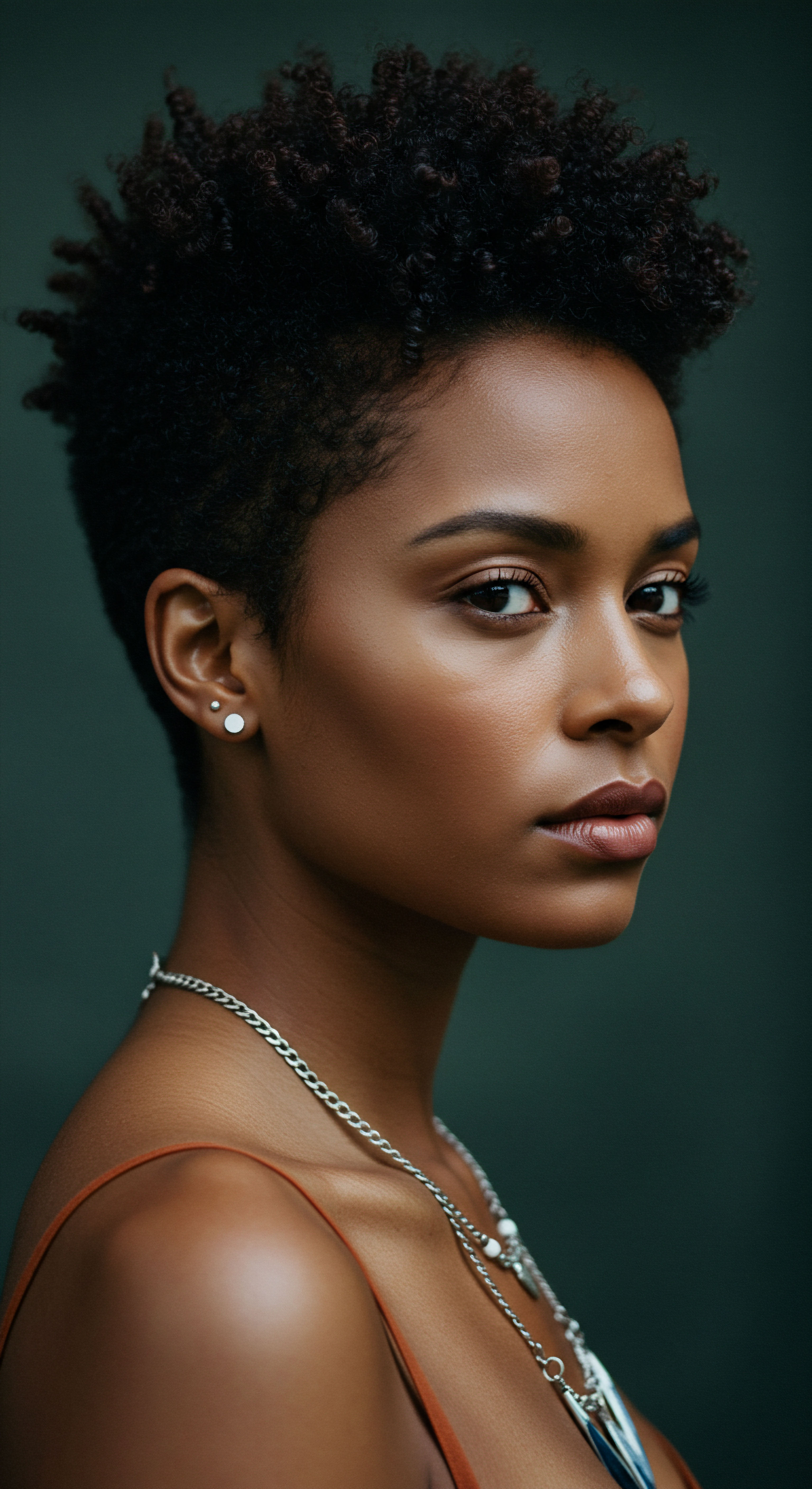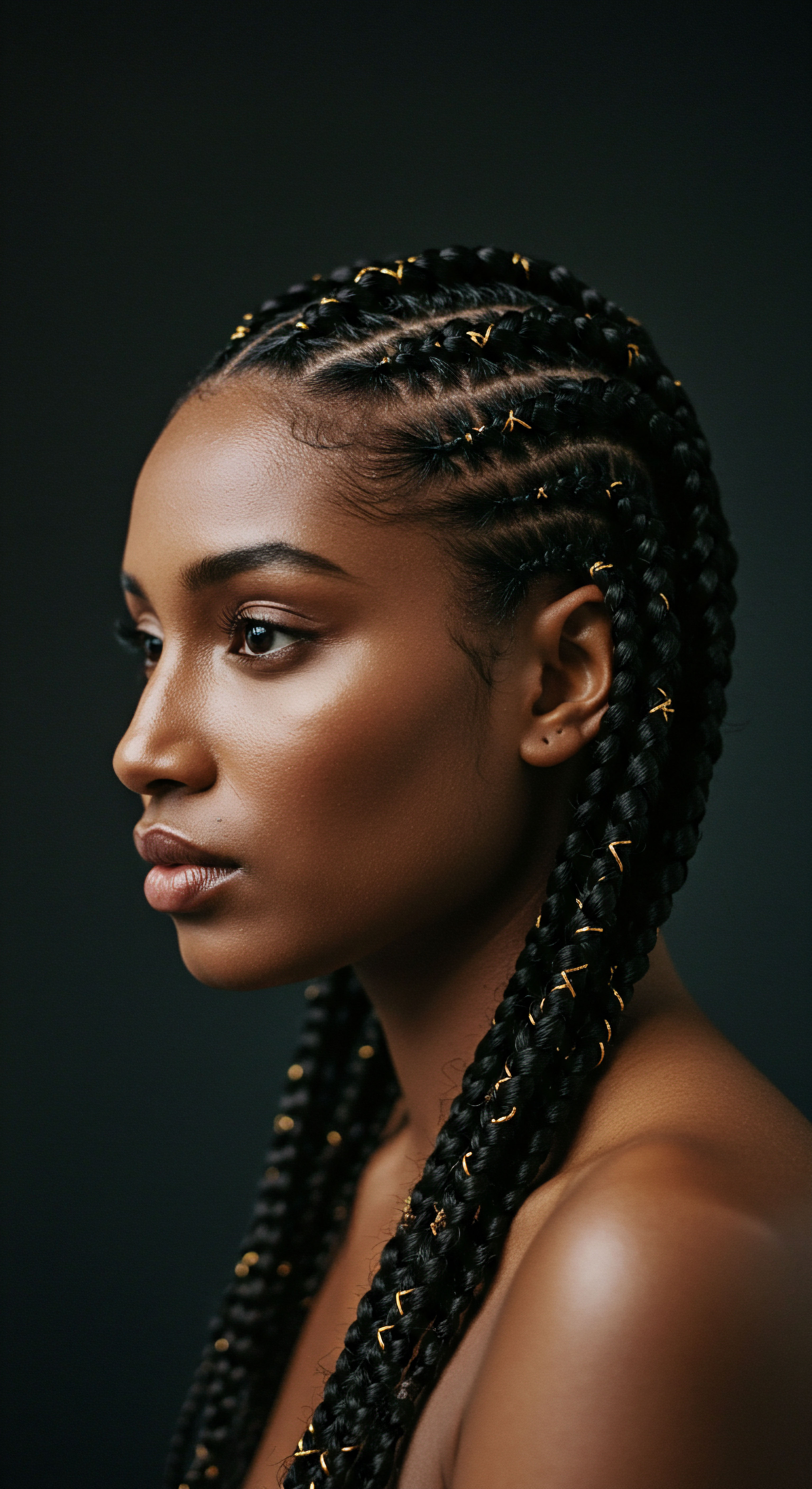
Roots
A quiet understanding settles upon us when we consider the stories held within each coil, each strand of textured hair. These are not merely fibers; they are ancestral lines, living chronicles that have, across millennia, whispered tales of belonging, power, and identity. To truly grasp the profound ways adornment has mirrored social standing in textured hair communities, we must first allow ourselves to journey back, far beyond the confines of contemporary perception, to where hair was undeniably a map of the soul, a public declaration etched onto the very crown of being. It was a language spoken through braids, beads, and carefully sculpted forms, legible to all who understood its ancient grammar.
From the sun-drenched plains of ancient Africa to the vibrant courts of powerful kingdoms, hair served as a visual lexicon. Its arrangement could signal age, marital status, lineage, wealth, and even spiritual devotion. This was a sophisticated system, where every twist and tie held meaning, where the absence or presence of certain adornments spoke volumes about an individual’s place within their collective.

Hair as a Cultural Cartography
The practice of shaping and adorning textured hair stretches back to the dawn of civilization, particularly within African societies where its significance transcended mere aesthetics. In ancient Egypt, for instance, elaborate wigs and intricate braided styles were not simply fashionable accessories; they were potent symbols of Royalty, divine connection, and elevated status. Priests and priestesses might adopt shaven heads as a sign of ritual purity, yet the elite often sported voluminous, highly styled coiffures, frequently embellished with gold, jewels, and aromatic oils, differentiating them sharply from the general populace. The meticulous care and resources required to maintain such elaborate styles underscored the wearer’s position at the pinnacle of society.
Hair adornment in ancient societies functioned as a visual language, articulating an individual’s social position and cultural identity.
Across various West African kingdoms, the artistry of hair reached unparalleled heights. Among the Yoruba People, for example, specific hairstyles were reserved for rulers, chiefs, and spiritual leaders. Cowrie shells, once a form of currency, were often incorporated into braids and twists, their presence signifying wealth and prosperity.
The famed suku style, a braided crown often seen on Yoruba women, could be adapted to denote marital status or a woman’s journey through different life stages. These styles were not static; they evolved with the individual’s life circumstances, acting as a living record of their personal history and societal role.
The Fulani people, known for their nomadic lifestyle, developed distinctive braiding patterns that were equally telling. Their long, delicate braids, often swept to the sides and adorned with silver coins, amber beads, and family heirlooms, were a clear indicator of a woman’s marital status, family wealth, and regional affiliation. The more elaborate the adornment, the greater the perceived status of the wearer and her family. These traditions were passed down through generations, ensuring the continuity of this visual language.

Adornment and Ritualistic Practice
Beyond mere display, the act of hair adornment itself often carried ritualistic weight. The process of styling, particularly in communities where hair was seen as a conduit to the divine or a repository of spiritual energy, became a communal act. Elder women, often revered for their wisdom and skill, would spend hours tending to the hair of younger generations, sharing stories, history, and life lessons during the process. This communal grooming reinforced social bonds and transmitted cultural knowledge, making the salon or the family compound a sacred space for intergenerational connection.
The Maasai of East Africa provide another compelling instance where hair adornment was intrinsically tied to social progression and warrior status. Young Maasai warriors would grow their hair long, styling it with red ochre and animal fat into intricate, often geometric, patterns. This distinct appearance marked them as part of a specific age set, signifying their strength, courage, and readiness for battle. Upon transitioning to elder status, their hair might be shaven or cut short, marking a different phase of life and responsibility.
These examples reveal that hair adornment was never a superficial concern within textured hair communities. It was, instead, a deeply ingrained practice, a powerful visual medium that communicated complex social structures, individual identity, and collective heritage, grounding individuals within their world.

Ritual
As we shift from the foundational understanding of hair’s significance, we encounter the active, deliberate practices that shape its expression. This section invites us to consider the intricate dance of hands, tools, and intentions that transforms raw fiber into a powerful statement. The rituals surrounding textured hair adornment are not simply about technique; they are about honoring tradition, marking passages, and making visible the invisible currents of social standing. These practices, often passed down through touch and observation, hold a quiet wisdom, guiding us through the nuanced ways hair becomes a canvas for societal roles.
The meticulous preparation and styling of textured hair frequently served as a public display of an individual’s place within the social hierarchy. The time, skill, and often precious materials invested in these coiffures were themselves indicators of status. A person with the leisure to spend hours on elaborate styling, or the means to commission a skilled artisan, inherently conveyed a certain standing.

How Did Specific Styling Rituals Signal Status?
In many African societies, the act of hair dressing was a highly specialized skill, often practiced by revered artisans. These stylists, frequently older women, held significant social standing due to their expertise and their role as keepers of cultural knowledge and communal stories. The intricate designs they created were not merely decorative; they were codes, understood by the community.
For example, among the Dinka People of South Sudan, men’s elaborate hair extensions and designs, meticulously maintained with great care, clearly indicated their age sets and social standing within the community. These styles could take days to construct and required constant upkeep, reflecting a commitment to cultural norms and a public presentation of one’s identity.
The tools employed in these rituals also held cultural significance. Combs carved from precious woods or bone, adorned with symbolic motifs, were not just functional items; they were often heirlooms, imbued with ancestral energy. Pins crafted from metals or adorned with rare stones served not only to secure a style but also to enhance its communicative power, adding layers of meaning and value. The very act of using these tools, often in a communal setting, reinforced the shared understanding of hair’s role in social expression.
The careful creation and maintenance of elaborate hairstyles served as a tangible expression of social privilege and community identity.

The Social Choreography of Hair Care
The communal aspect of hair care cannot be overstated. It was, and in many places remains, a fundamental social practice. Children would learn the techniques from their mothers, aunts, and grandmothers, observing the delicate movements and absorbing the stories that accompanied each session. This transmission of knowledge was not just about styling; it was about the perpetuation of cultural identity and social norms.
In the Mende Society of Sierra Leone, for instance, women’s elaborate coiffures, particularly those associated with the Bundu society (a powerful women’s initiation society), symbolized spiritual authority, wisdom, and leadership. These styles were often complex, requiring multiple hands to create, underscoring the collaborative nature of communal life and the shared responsibility for upholding cultural standards.
- Life Stage Styles ❉ Many societies employed distinct hair rituals to mark significant transitions in an individual’s life. Styles changed dramatically from childhood to adolescence, then again upon marriage, childbirth, and entry into elderhood. These changes were not arbitrary; they were publicly visible markers of new responsibilities, rights, and roles within the community.
- Protective Adornment ❉ Beyond aesthetics, certain adornments served protective purposes, both practical and spiritual. Beads, cowrie shells, or specific herbs woven into hair could be believed to ward off evil spirits or provide good fortune, further elevating the hair’s role beyond mere display.
- Mourning Practices ❉ In times of grief, hair rituals often shifted dramatically. Shaving the head, leaving hair unkempt, or adorning it with specific materials could all signify a period of mourning, clearly communicating a person’s emotional state and temporary withdrawal from certain social functions.
These rituals underscore that textured hair adornment was never a solitary act or a simple choice of fashion. It was a deeply embedded practice, a choreography of cultural values and social realities, where every strand, every bead, and every communal touch contributed to a powerful, visible declaration of one’s place in the world.

Relay
To understand the enduring echoes of hair adornment as a social marker, we must now consider how these historical practices have been transmitted, challenged, and reinvented across generations and continents. This segment invites a deeper reflection, one that acknowledges the profound interplay of historical forces, cultural resilience, and the quiet yet powerful assertion of identity through hair. Here, science, cultural memory, and intricate details converge, revealing how the very structure of textured hair has become a testament to human adaptability and a consistent, albeit sometimes silent, declaration of self and standing.
The transatlantic slave trade and subsequent colonialization profoundly disrupted indigenous hair practices, often forcing a suppression of traditional adornments. Yet, even in the face of immense adversity, textured hair communities found ways to preserve, adapt, and transform their hair traditions, making them powerful symbols of resistance and continuity. The forced standardization of appearance under oppressive regimes inadvertently lent new meaning to hair, turning it into a silent language of defiance.

How Did Historical Oppression Shape Hair Adornment as a Social Signal?
During the era of enslavement in the Americas, hair adornment took on a clandestine yet potent significance. While elaborate styles and traditional adornments were often forbidden or impractical, enslaved individuals ingeniously adapted. Braids, for instance, were not merely a way to manage hair; they could serve as maps to freedom, encoding escape routes or communicating messages within their patterns.
Seeds, rice, or gold dust were sometimes hidden within braids, serving as a means of survival or a hidden form of wealth. This transformed hair into a vessel for Resistance and a secret marker of community and hope, where subtle adornments or styling choices, though seemingly simple, held immense social and personal weight.
A compelling example of this resilience, often overlooked in its economic dimension, is the continued practice of hair dressing and the development of specialized hair care within enslaved communities. While often performed under harsh conditions, the skills of hair braiders and stylists were highly valued. These individuals not only maintained personal hygiene and aesthetic connection to heritage but also provided a vital service that, in some instances, allowed for small, informal economies to develop. This underscores that even in the most dehumanizing circumstances, the care and adornment of textured hair retained its social currency.
For instance, academic works such as “The Cultural History of Hair” by Richard Corson (1965) and “Hair Story ❉ Untangling the Roots of Black Hair in America” by Ayana Byrd and Lori Tharps (2001) document how skilled enslaved women were sometimes hired out by their enslavers to style the hair of others, including white women, earning meager sums that occasionally allowed them to purchase their freedom or that of loved ones. This demonstrates a unique, albeit painful, instance where the mastery of textured hair adornment directly translated into a form of social and economic leverage, however limited, within an oppressive system.
| Historical Period Ancient Africa (e.g. Yoruba) |
| Adornment Practice Ornate braided crowns with cowrie shells |
| Social Signal Wealth, marital status, spiritual authority |
| Historical Period Pre-Colonial West Africa (General) |
| Adornment Practice Specialized stylists, elaborate multi-day styles |
| Social Signal Leisure, economic means, social standing of patron and artisan |
| Historical Period Slavery Era (Americas) |
| Adornment Practice Braids encoding messages, hidden items |
| Social Signal Resistance, secret communication, survival |
| Historical Period Post-Emancipation (e.g. Early 20th Century) |
| Adornment Practice Pressing, straightening to conform to dominant norms |
| Social Signal Assimilation, respectability, professional ambition |
| Historical Period Civil Rights/Black Power Movement |
| Adornment Practice The Afro, natural hair movement |
| Social Signal Racial pride, political defiance, cultural authenticity |
| Historical Period Hair has consistently served as a powerful, evolving medium for social commentary and personal identity within textured hair communities. |

How Do Contemporary Hair Choices Echo Ancestral Practices?
The reverberations of these historical struggles and triumphs are palpable in contemporary textured hair communities. The natural hair movement, which gained significant momentum in the late 20th and early 21st centuries, is a powerful continuum of this historical narrative. Choosing to wear one’s hair in its natural state, free from chemical alterations or excessive heat, is a conscious act of reclaiming ancestral aesthetics and asserting cultural pride. This choice, while personal, carries significant social weight, often challenging Eurocentric beauty standards and fostering a sense of collective identity and empowerment.
The enduring power of textured hair adornment lies in its ability to simultaneously honor heritage and articulate contemporary identity.
Today, the diverse array of protective styles—braids, twists, locs—continue to signify belonging, creativity, and a connection to a rich cultural heritage. These styles, while aesthetically pleasing, also represent a deeper understanding of hair health and preservation, echoing the practical wisdom of ancestors who meticulously cared for their strands. The economic ecosystem surrounding textured hair today, from specialized products to skilled stylists, mirrors the historical value placed on hair care and adornment, albeit in a globalized context.
- Locs as Legacy ❉ The choice to wear locs, for instance, often symbolizes a deep connection to spiritual and cultural heritage, representing patience, growth, and a rejection of fleeting trends. They carry a distinct social signal of rootedness and authenticity.
- Braids and Community ❉ Braiding sessions, whether in a salon or at home, continue to serve as spaces for communal bonding, sharing stories, and transmitting knowledge, much like their ancient counterparts. The intricacy of a braided style can still signal dedication and a connection to cultural artistry.
- Digital Spaces as New Relays ❉ Social media platforms have become new arenas for displaying and discussing textured hair adornment, allowing for the rapid dissemination of styles and ideas, and fostering global communities united by shared hair experiences and aesthetic values.
The journey of textured hair adornment, from ancient symbols of royalty to contemporary expressions of pride and resistance, is a profound testament to its enduring power. It serves as a living record, a relay of history, culture, and social standing, constantly evolving yet always connected to its deep, meaningful roots.

Reflection
The enduring story of adornment in textured hair communities is a quiet symphony, each strand a note, each style a movement, collectively composing a powerful narrative of identity, resilience, and belonging. It is a story that reminds us how deeply our outward expressions are intertwined with our inner worlds and our place within the collective. The care, creativity, and intention poured into textured hair, from ancient courts to modern streets, speak to a wisdom that transcends time—a recognition that the crown we wear is not merely an accessory, but a profound declaration of who we are, where we come from, and the strength we carry forward.

References
- Corson, Richard. The Cultural History of Hair. New York ❉ Crown Publishers, 1965.
- Byrd, Ayana, and Lori Tharps. Hair Story ❉ Untangling the Roots of Black Hair in America. New York ❉ St. Martin’s Press, 2001.
- Patton, Tracey Owens. “African-American Women, Hair, and Self-Esteem.” The Journal of Black Psychology 31, no. 3 (2005) ❉ 288-302.
- Mercer, Kobena. “Black Hair/Style Politics.” Welcome to the Jungle ❉ New Positions in Black Cultural Studies. New York ❉ Routledge, 1994.
- Hooks, Bell. “Selling Hot Pussy ❉ Representations of Black Female Sexuality in Popular Culture.” Black Looks ❉ Race and Representation. Boston ❉ South End Press, 1992.
- Okoro, Nkem. “Hair and the African Worldview.” The Journal of Pan African Studies 2, no. 1 (2007) ❉ 101-113.
- Gordon, Vivian Verdell. Black Women, Feminism, and Black Liberation ❉ Which Way? Chicago ❉ Third World Press, 1987.
- Kaba, Amadou. “The Socio-Cultural and Economic Dimensions of Hairdressing in African Societies.” Journal of African Studies 1, no. 2 (2010) ❉ 45-62.
- Bank, Leslie J. “Hair, Power, and Resistance ❉ The Tignon and the Social Construction of Race in Colonial Louisiana.” Louisiana History ❉ The Journal of the Louisiana Historical Association 45, no. 2 (2004) ❉ 159-182.
- Sieber, Roy, and Frank Herreman. Hair in African Art and Culture. New York ❉ The Museum for African Art, 2000.